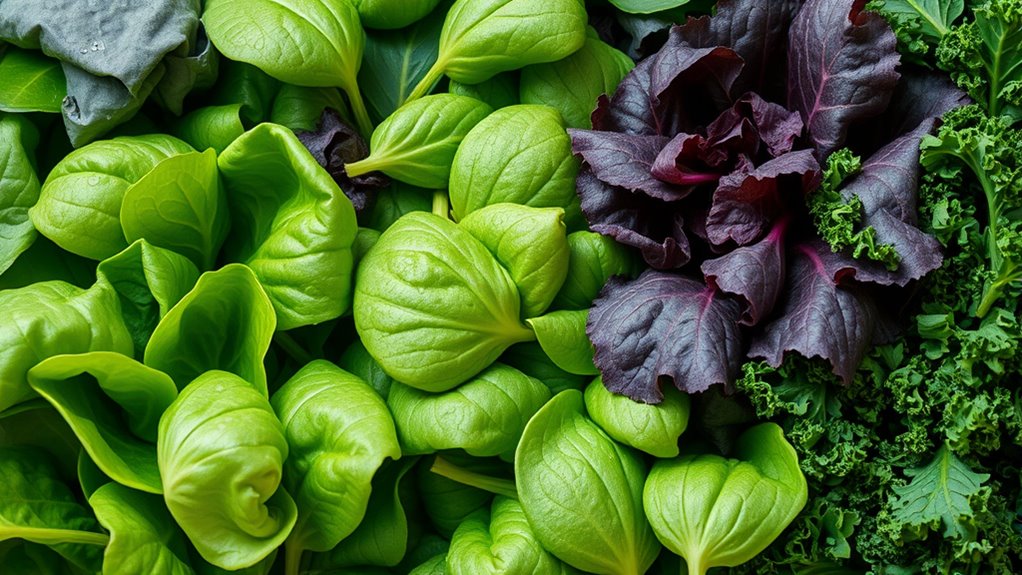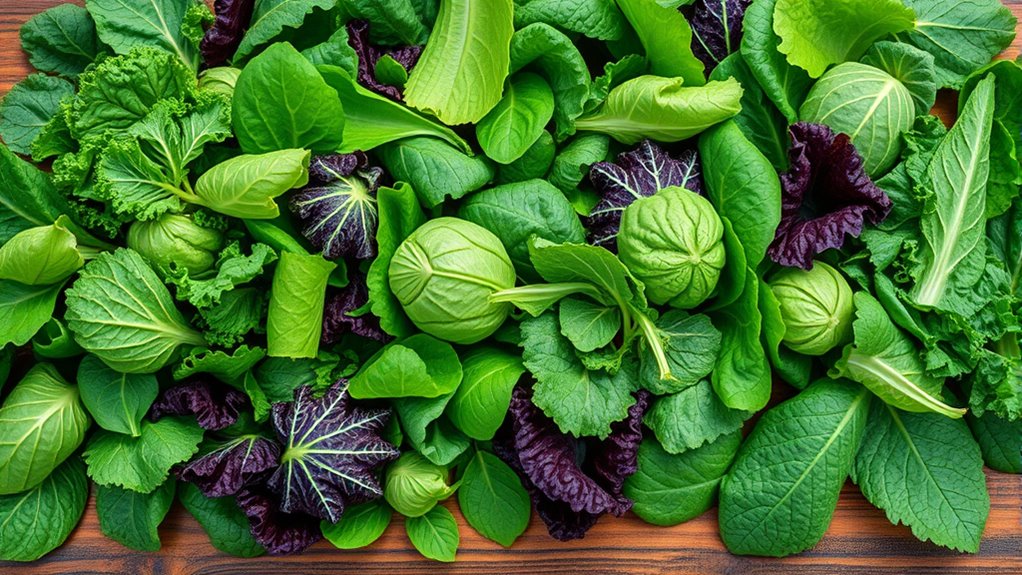To avoid bitterness in leafy greens, rotate different varieties like lettuce, spinach, kale, and Swiss chard each season. Moving greens to new spots prevents soil depletion and disrupts pests and disease cycles that cause bitterness. Incorporate companion plants like carrots or herbs to repel pests naturally. Using crop rotation and cover crops keeps your soil healthy and nutrient-rich, which helps produce tender, flavorful greens. Keep exploring to learn more tips for a thriving, delicious leafy greens garden.
Key Takeaways
- Rotate different leafy greens to prevent overgrowth stress that causes bitterness.
- Incorporate companion plants like herbs or carrots to deter pests and reduce plant stress.
- Avoid planting the same greens in the same spot annually to minimize soil-borne disease buildup.
- Use proper harvesting techniques and timely harvesting to prevent greens from becoming bitter.
- Maintain healthy soil with crop rotation and cover crops to promote lush, flavorful greens.

Are you looking to improve your garden’s productivity and soil health? If so, implementing a thoughtful leaf greens rotation can make a significant difference. Rotating your leafy greens not only prevents soil depletion but also helps break pest and disease cycles. By planning your planting schedule wisely, you can cultivate a variety of greens without the bitterness that often comes with overgrown or stressed plants. One effective strategy is companion planting, which involves pairing your leafy greens with other plants that support their growth. For example, planting carrots or onions nearby can help deter pests like aphids and whiteflies, making pest management easier and more natural. This method reduces the need for chemical interventions and keeps your greens healthier.
When planning your leafy greens rotation, consider how different varieties interact with their environment and pests. Leafy greens like lettuce, spinach, kale, and Swiss chard have varying nutrient needs and growth habits, so rotating them prevents soil exhaustion. It also minimizes the risk of disease buildup, which can flourish in monoculture systems. As you rotate crops, planting the same greens in the same spot year after year can lead to a decline in yield and quality. Instead, move them to different beds or sections of your garden, ideally combining this with companion planting to enhance pest management naturally. For instance, planting mustard greens with herbs like dill or cilantro can further repel pests and attract beneficial insects.
Another key benefit of leafy greens rotation is reducing the likelihood of soil-borne diseases, which can quickly spread through continuous planting of the same crop. By switching up your greens, you disrupt the lifecycle of pests and pathogens, making it harder for infestations to take hold. Additionally, rotating with crops that have different root structures and nutrient requirements helps maintain soil robustness. Incorporating cover crops or legumes during off-seasons to further boost soil health, ensuring your greens grow in nutrient-rich conditions. Furthermore, implementing integrated pest management strategies is essential for effective and sustainable pest control.
Ultimately, a well-structured leafy greens rotation, combined with companion planting, creates a balanced ecosystem in your garden. This approach minimizes pest problems, reduces reliance on chemical controls, and promotes lush, flavorful greens without bitterness. With careful planning, you’ll enjoy a continuous harvest of fresh, tender leaves throughout the growing season while maintaining a healthy garden environment. Keep track of your rotations, experiment with different combinations, and watch your garden thrive with vibrant, tasty greens year after year.
Frequently Asked Questions
How Often Should I Rotate My Leafy Greens?
You should rotate your leafy greens every planting season or every few weeks to promote healthy crop succession and prevent soil depletion. This practice helps with soil enrichment by reducing disease buildup and pest problems. By changing your greens’ location regularly, you guarantee your soil stays fertile and productive, leading to tastier, less bitter greens. Keep track of your rotations to maintain a balanced and sustainable garden.
Which Greens Are Best for Beginner Gardeners?
Think of your garden as a friendly neighborhood, where beginner greens like lettuce, spinach, and arugula are the welcoming neighbors. These greens thrive with proper soil preparation and benefit from companion planting, which keeps pests away naturally. They’re easy to grow, quick to sprout, and forgiving if you make a mistake. Start with these, and you’ll build confidence while enriching your soil and creating a harmonious garden community.
Can I Grow Leafy Greens Indoors Year-Round?
Yes, you can grow leafy greens indoors year-round. Make sure you provide ample indoor lighting, like grow lights or a sunny window, to mimic sunlight. Choose the right container with good drainage, and use rich, well-draining soil. Keep the soil consistently moist and maintain a steady temperature. With proper container selection and indoor lighting, you’ll enjoy fresh greens anytime, regardless of the season.
What Are Common Pests Affecting Leafy Greens?
You’ll want to watch for pests like aphids, slugs, and whiteflies that commonly affect leafy greens. To identify these pests, do pest identification regularly. Once you spot them, use organic pest control methods such as neem oil, insecticidal soap, or introducing beneficial insects like ladybugs. Keeping your greens healthy and clean helps prevent infestations, ensuring a tasty, bitterness-free harvest all year round.
How Do I Prevent Bitterness in Leafy Greens?
To prevent bitterness in leafy greens, you should harvest them early, as mature leaves tend to develop a bitter taste. Regular watering and proper fertilization help maintain their leafy greens flavor, keeping them tender and sweet. Additionally, avoid letting greens bolt by providing consistent moisture and cool temperatures. These steps guarantee you enjoy fresh, flavorful greens without the unwanted bitterness, making your salads and dishes more enjoyable.
Conclusion
By rotating your leafy greens, you not only enjoy a variety of flavors without bitterness but also boost your garden’s health. Did you know that rotating crops can reduce pest problems by up to 50%? This simple practice keeps your soil rich and your greens delicious. So, mix things up in your planting schedule—your taste buds and plants will thank you for it! Happy gardening and flavorful salads ahead!
Cindy thoroughly researches juicing trends, techniques, and recipes to provide readers with practical advice and inspiration. Her writing style is accessible, engaging, and designed to make complex concepts easy to understand. Cindy’s dedication to promoting the advantages of juicing shines through her work, empowering readers to make positive changes in their lives through the simple act of juicing.
















